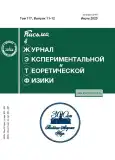Inclusion of the Energy Distribution of Free Carriers in the Rate Equations Describing Their Dynamics at the Interaction of Dielectrics with Intense Laser Radiation
- Autores: L'vov K.V1, Stremoukhov S.Y.1,2
-
Afiliações:
- Moscow State University, 119234, Moscow, Russia
- National Research Center Kurchatov Institute, 123182, Moscow, Russia
- Edição: Volume 117, Nº 11-12 (6) (2023)
- Páginas: 904-911
- Seção: Articles
- URL: https://journals.rcsi.science/0370-274X/article/view/145242
- DOI: https://doi.org/10.31857/S1234567823120066
- EDN: https://elibrary.ru/EVVOOQ
- ID: 145242
Citar
Texto integral
Resumo
The dynamics of free carriers in CaF2 induced by intense femtosecond radiation of the near- (1.24 μm) and mid- (4.4 μm) infrared ranges has been studied. It has been shown that the energy distribution of carriers formed after the passage of a laser pulse with a fluence sufficient for active impact ionization has a shape independent of the parameters (fluence, duration, and wavelength) of laser radiation and the width of the band gap of the material. The mean kinetic energy of free carriers after the action of the pulse is 0.56 of the width of the band gap. The inclusion of the dispersion term in rate carrier dynamics models makes it possible to reduce the difference of the mean kinetic energy from the statistical Fokker–Planck model by 30%. The application of rate carrier dynamics models instead of statistical models requiring large time and computational resources allows one to accelerate calculations by a factor of 20.
Sobre autores
K. L'vov
Moscow State University, 119234, Moscow, Russia
Email: lvov.kv14@physics.msu.ru
S. Stremoukhov
Moscow State University, 119234, Moscow, Russia; National Research Center Kurchatov Institute, 123182, Moscow, Russia
Autor responsável pela correspondência
Email: lvov.kv14@physics.msu.ru
Bibliografia
- S. Ghimire, A. D. DiChiara, E. Sistrunk, U. B. Szafruga, P. Agostini, L. F. DiMauro, and D. A. Reis, Phys. Rev. Lett. 107, 167407 (2011).
- E. Goulielmakis and T. Brabec, Nature Photon. 16, 411 (2022).
- V. V. Strelkov, V. T. Platonenko, A. F. Sterzhantov, and M. Yu. Ryabikin, Phys.-Uspekhi 59, 425 (2016).
- O. Schubert, M. Hohenleutner, F. Langer, B. Urbanek, C. Lange, U. Huttner, D. Golde, T. Meier, M. Kira, S. W. Koch, and R. Huber, Nature Photon. 8, 119 (2014).
- N. Sanner, O. Ut'eza, B. Bussiere, G. Coustillier, A. Leray, T. Itina, and M. Sentis, Appl. Phys. A 94, 889 (2009).
- M. Lenzner, Int. J. Modern Phys. B 13, 1559 (1999).
- E. I. Mareev, B. V.Rumyantsev, and F. V. Potemkin, JETP Lett. 112, 780 (2020).
- C. B. Scha er, A. Brodeur, and E. Mazur, Meas. Sci. Technol. 12, 1784 (2001).
- S. Yu. Stremoukhov, A. V. Andreev, and O. A. Shoutova, Bull.Russ. Acad. Sci. Phys. 80, 500 (2016).
- S. V. Sazonov and N. V. Ustinov, Bull.Russ. Acad. Sci. Phys. 84, 5 (2020).
- E. Mareev, A. Pushkin, E. Migal, K. Lvov, S. Stremoukhov, and F. Potemkin, Sci. Rep. 12, 7517 (2022).
- E. M. Gershenzon, M. E. Gershenzon, G. N. Gol'tsman, A. M. Lyul'kin, A. D. Sernenov, and A. V. Sergeev, JETP Lett. 46, 226 (1987).
- A. S. Epifanov, A. A. Manenkov, and A. M. Prokhorov, JETP 70, 728 (1976).
- A. Kaiser, B. Rethfeld, M. Vicanek, and G. Simon, Phys. Rev. B 61, 437 (2000).
- L. H. Holway, J. Appl. Phys. 45, 677 (1974).
- B. C. Stuart, M. D. Feit, S. Herman, A. M.Rubenchik, B. W. Shore, and M. D. Perry, Phys. Rev. B 53, 1749 (1996).
- B. C. Stuart, M. D. Feit, A. M.Rubenchik, B. W. Shore, and M. D. Perry, Phys. Rev. Lett. 74, 2248 (1995).
- B. Rethfeld, Phys. Rev. Lett. 92, 18740 (2004).
- K. V. Lvov, F. V. Potemkin, and S. Yu. Stremoukhov, Materials Today Communications 35, 105594 (2023).
- L. V. Keldysh, JETP 10, 509 (1960).
- N. Medvedev and B. Rethfeld, J. Appl. Phys. 108, 103112 (2010).
- L. V. Keldysh, JETP 47, 1945 (1964).
- M. Gryzin'ski, Phys. Rev. 138, A336 (1965).
- P. Balling and J. Schou, Rep. Prog. Phys. 76, 036502 (2013).
- E. Migal, A. Pushkin, B. Bravy, V. Gordienko, N. Minaev, A. Sirotkin, and F. Potemkin, Opt. Lett. 44, 2550 (2019).
Arquivos suplementares









